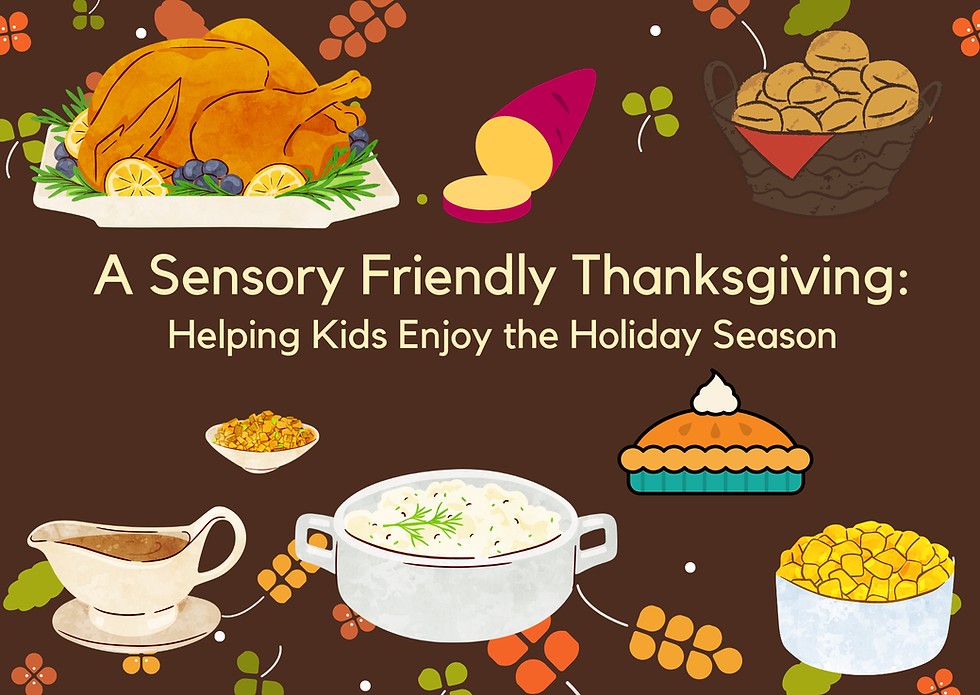Co-Regulation
- Maddie Bernhardt, OT Intern
- Nov 10, 2023
- 3 min read

Overview
Self-regulation of emotions is an important skill that helps children have control over their thoughts, feelings, and behaviors. This ability supports their success in so many different areas including academically and socially! However, it isn’t something that kids can learn on their own. Children rely on a process called co-regulation to help calm themselves appropriately.[1]
What is co-regulation?
Co-regulation is the ability to regulate emotions and behaviors with the support of another responsive individual. Over time, this consistent support provided by caregivers will help children become more independent in their self-regulation.[1] Some components of self-regulation that children learn through co-regulation are social and emotional awareness, perspective-taking, problem-solving skills, and empathy.[2] Learning self-regulation skills is a trial-and-error process, so co-regulation is necessary throughout childhood.[1] Understanding what co-regulation is, why it is important, and strategies that you can use to support co-regulation will provide a strong foundation for your child to begin developing their own set of effective emotional self-regulation strategies.
What does co-regulation look like?
1. Remain calm and consistent: Especially during infancy, it is important to project calmness while soothing your child.[1] Children often mirror the energy of their caregiver, so throughout each strategy, it is important to remain calm. This can be difficult when you are feeling dysregulated yourself. See below for some strategies to self-regulate!
2. Verbalizing emotions: Emotions can be a challenging concept for children to understand, so it is important to have conversations about them. This can include labeling feelings and linking them to specific events and behaviors.[2]
a. Example: “I see that your fists are clenched, you must be feeling angry!”
3. Validate emotions: An important aspect of co-regulation is creating a safe and trusting environment which can involve empathetic listening and validating of emotions.
a. Example: “I see that your fists are clenched, you must be feeling angry! It can be hard to leave the playground when we’re having fun.”
4. Encourage coping/distraction: As your child starts to grasp their emotions, you can add in conversations about ways to regulate. These can include ways your child can be redirected away from their stressor.
a. Example: “I see that your fists are clenched, you must be feeling angry! It can be hard to leave the playground when we’re having fun. We can take a drink of water to help our body feel better.”
5. Modeling emotions: One aspect of co-regulation is demonstrating how you self-regulate to manage your emotions.
a. Example: “I’m feeling frustrated because I can’t find the car keys. I’m going to take a deep breath to help me feel better and keep looking.”
Self-regulation Strategies
In order to best help your child regulate, you have to prioritize your own emotional regulation!
The first step in self-regulation is to breathe. During intense emotional moments with your child, take a second to pause and breathe. This can help you reset and calm down before you respond. As you take a second to breathe, consider your child’s perspective. Think about what is causing this moment and how your child must be feeling to be reacting this way. Sometimes, you still might find yourself dysregulated. If so, remember to be kind and compassionate to yourself. It’s okay to step away and take a break if needed. By focusing on your own self-regulation, you will be better equipped to help your child with theirs.
[1] Gillespie, L. (2015). It takes two: The role of co-regulation in building self-regulation skills. National Association for the Education of Young Children.
[2] Silkenbeumer, J., Schiller, E. M., Holodynski, M., & Kartner, J. (2016) The role of co-regulation for the development of social-emotional competence. Journal of Self-Regulation and Regulation, 2. 17-32. http://dx.doi.org/10.11588/josar.2016.2.34351




Comments